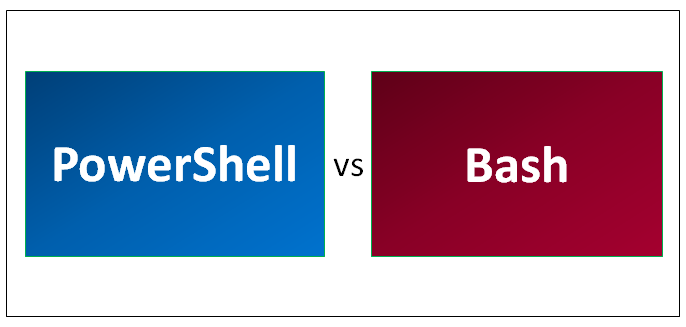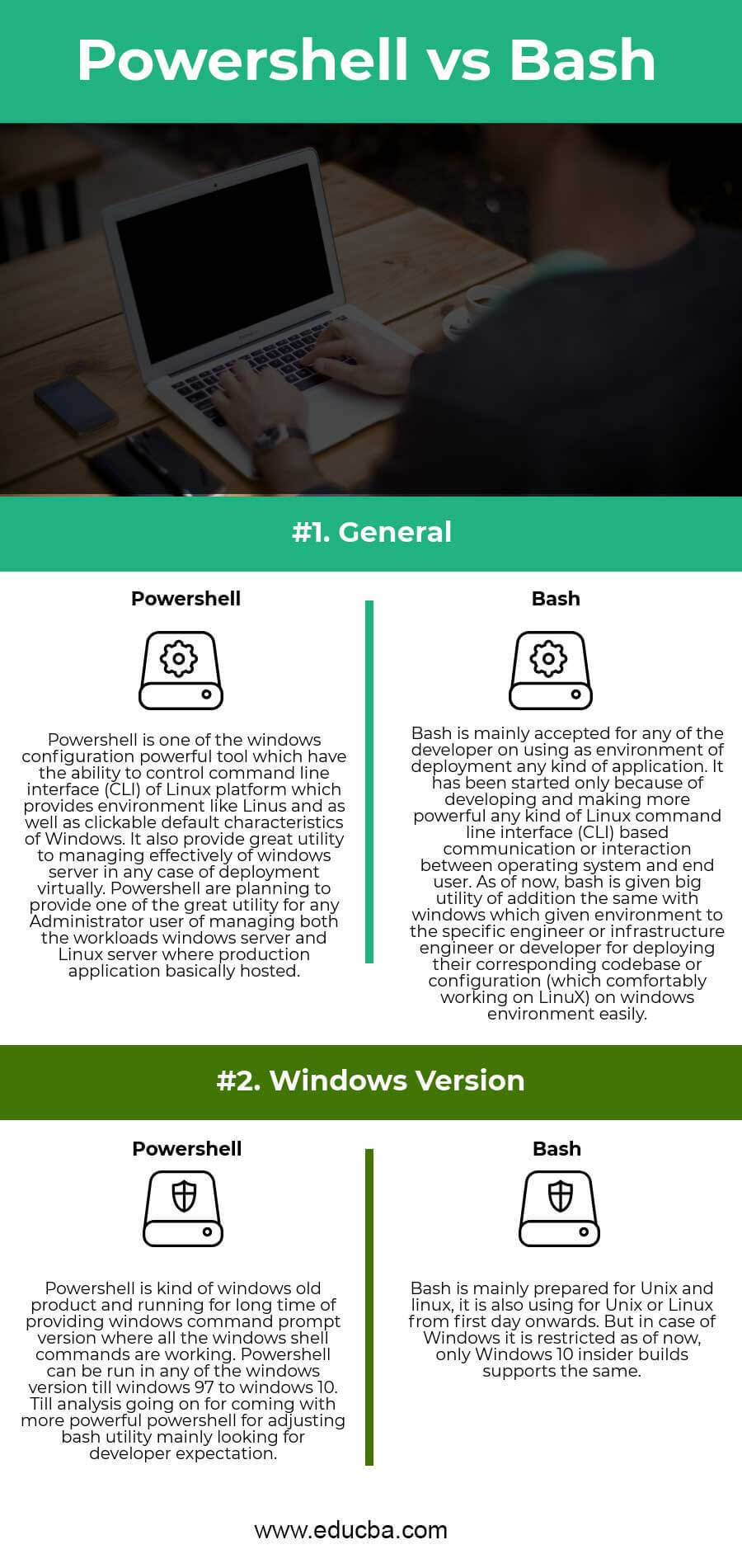Updated March 2, 2023
Difference Between PowerShell vs Bash
Powershell vs Bash both provide one intelligent command line interface by using their own configuration management tool. Powershell is normally popular in case of Windows operating system, it provides a good environment for the end-user to utilize the command prompt and execute windows specific commands. Whereas bash is normally used in the UNIX environment, and most popular for the developer who is willing to deploy their application or code-base for better utilization. Deploy in bash will always be the most secure approach to work with any kind of secure code deployment. As considering the developer requirement, Windows are planning to introduce bash in the windows environment, their strategy is to provide UNIX kind of environment in windows for a better choice to any developer for their deployment.
It will provide dual booting in the environment of canonical’ s Ubuntu operating system which actually gives the end- user a flavor of native Linux or Unix functionalities. That’s why in the current world there are common discussions that Bash will take over the entire powershell market specifically in the Windows environment. Bash is providing windows environment similar to Unix or Linux systems and also gives one big utility of OpenSSH connectivity which is the most secure security as it follows the secure shell protocol. Powershell provides proper windows specific Microsoft native scripting or automates scripting platform, which helds both Linux kind of command line interface (CLI) and pure clickable windows native environment, which attracts the developer for using the same as a virtual deployment environment.
Head to Head Comparison Between PowerShell and Bash (Infographics)
Below are the top 2 differences between PowerShell and Bash:
Key Differences between PowerShell and Bash
Let us discuss some of the major differences between PowerShell and Bash:
- Powershell is not considered as a default shell it is actually different than any other shell which works in the operating system. It actually works as a simple scripting environment where any kind of commands which are mainly lightweight as example cmdlets can run very easily without creating any issue. This command can run through command prompt or automated script or through any defined API. Any kind of operating system controls even the old operating system at all times in fully working condition in PowerShell. It also uses very good features of aliases, which mainly powerful to provide the proper reference of old command in that corresponding new command or script. Whereas in case of bash, it supports all kinds of Unix or Linux command, it is very much useful for developers as deploying environment for their codebase. Any kind of operating system command is not able to support, even some old command does not always properly work here. But bash is given the same command with some syntactical changes, but the output can be the same if we look at the end-user. Bash and dir from PowerShell almost provide the same output to the end-user.
- Powershell has one big implementation like object pipeline. It always maintains the pipelining of every object for proper integration. It always passes one object output to another object as input. Suppose we have executed one command like a cmdlet, then it will execute and go as input for another object, then it displays in the end-user output screen. There are possibilities of manipulating sequentially multiple cmdlets easily by using this kind of object pipeline approach. If the end-user needs to share or copy complex data or willing to pass entire structure of data to another environment through command prompt then the object pipeline is the best and helpful option in case of Powershell. Whereas bash is not followed in the object structure, the input and output are basically preferred as plain text. So it will always be easy for any user to transform their information through bash, as it always follows plain text structure as input and output, which is better understandable for the next program.
- In the case of comparison commands, there has some basic difference between Powershell vs Bash, Powershell normally uses below comparison commands for writing the script.
-eq, -no, -ceq, -cane
Bash using some comparison commands for writing the script:
=, !=
Powershell and Bash Comparison Table
Let’s look at the top comparison between Powershell and Bash.
| Basic Comparison between Powershell vs Bash | Powershell | Bash |
| General | Powershell is one of the windows configuration powerful tools which have the ability to control command-line interface (CLI) of the Linux platform which provides the environment like Linux and as well as clickable default characteristics of Windows. It also provides great utility to manage effectively on a windows server in any case of deployment virtually. Powershell is planning to provide one of the great utility for any Administrator user of managing both the workloads windows server and Linux server where production application is basically hosted. | Bash is mainly accepted for any of the developers on using as the environment of deployment any kind of application. It has been started only because of developing and making more powerful any kind of Linux command-line interface (CLI) is based on communication or interaction between the operating system and end-user. As of now, bash is given big utility of adding the same with windows which gives environment to the specific engineer, infrastructure or developer for deploying their corresponding codebase or configuration (which is comfortable working on Linux) on windows environment easily. |
| Windows Version | Powershell is a kind of windows old product and running for a long time of providing windows command prompt version where all the windows shell commands are working. Powershell can run in any of the windows version till windows 97 to windows 10. Till analysis going forward, Windows is coming with more powerful PowerShell for adjusting bash utility mainly looking for developer expectation. | Bash is mainly prepared for Unix and Linux, it is also using for Unix or Linux from the first day onwards. But in the case of Windows, it is restricted as of now, only Windows 10 insider builds support the same. |
Conclusion
Powershell vs Bash both are a very much popular configuration management tool for two different operating systems Windows and Unix. As Bash follows the textual structure for transferring messages and all, the developer is always preferring to deploy their code in UNIX box, whereas Powershell is very much popular for the normal user for their clickable functionality which is very much user-friendly than bash.
Recommended Articles
This has been a guide to the top difference between Powershell vs Bash. Here we have discussed Powershell vs Bash head to head comparison, key differences along with infographics and comparison table respectively. You may also have a look at the following articles to learn more –
- Linux vs Windows 10 | Differences
- Ubuntu vs FreeBSD | Comparison
- JSON vs AJAX
- Jira vs Asana | Comparison
- Jira vs Trello: Differences
- JIRA vs TFS: What are the Differences
- Jira vs Redmine: Differences
- JSON vs SOAP: What are the Comparison
- PowerShell vs Command Prompt | Top 14 Differences
- What is Bash? | Versions | Usage




